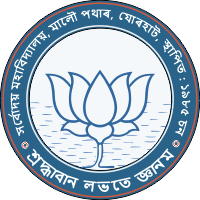Department Profile
| 1 | NAME OF | DEPARTMENT | ECONOMICS | ||||||
| 2 | YEAR OF ESTABLISHMENT | GOVT. CONCURRENCE | 2001 | 2004 | |||||
| 3 | NAME OF PROGRAMME/ COURSE OFFERED | B.A. PROGRAMME | |||||||
| 4 | ANNUAL/SEMESTER/CBCS( PROGRAMMEWISE) | CBCS | |||||||
| 5 | COURSES IN COLLABORATION WITH OTHER UNIVERSITIES | ||||||||
| INDUSTRIES,ETC. | NO | ||||||||
| 6 | DETAILS COURSE/PROGRAMMES DISCONTINUES | NO | |||||||
| WITH REASONS | |||||||||
| 7 | NUMBER OF TEACHING POSTS | 4 | POSTS | SANCTIONED | FILLED | ||||
| ALL POSTS ARE IN THE DEPARTMENT YET TO | PROFESSOR | NIL | NIL | ||||||
| BE PROVINCIALISED. | |||||||||
| ASSOCIATE | |||||||||
| PROFESSOR | NIL | NIL | |||||||
| ASSISTANT | |||||||||
| PROFESSOR | NIL | 4 | |||||||
| 8 | FACULTY FROFILE | SEE ANNEXURE-01 | |||||||
| NAME | QUALIFICATION | SPECIALIZATION | EXPERIENCE (YRS) | NO. OF Ph.D STUDENTS | |||||
| DESIGNATION | GUIDED IN LAST 5 YEARS | ||||||||
| 9 | LIST OF SENIOR VISITING FACULTY/GUEST | NIL | |||||||
| 10 | PERCNTAGE OF LECTURES DELIVERED AND PRACTICAL CLASSES | ||||||||
| HANDLED BY GUEST FACULTY | NO | ||||||||
| 11 | STUDENT-TEACHER RATIO | 2016-17 | 9:01 | ||||||
| 2017-18 | 14:01 | ||||||||
| 2018-19 | 14:01 | ||||||||
| 2019-20 | 10:01 | ||||||||
| 2020-21 | 5:01 | ||||||||
| 12 | QUALIFICATION OF TEACHING FACULTY WITH | D.Litt | Ph.D | M.Phil. | |||||
| SEE ANNEXURE 02 | |||||||||
Click here for more information:
Course Plan:
COURSE PLAN FOR THE SESSION 2019-2022
DEPARTMENT--: ECONOMICS , 1ST SEM. PROGRAME CODE:UG-CBCS PAPER NAME: INTRODUCTORY MICROECONOMICS PAPER CODE: C1
|
SRLNO |
UNIT NO |
TOTAL CLASS |
DURATION OF CLASS |
CLASS PER SESSION |
TOPIC TAUGHT |
METHODOLOGY APPLIED |
CLASS WORK |
ASSESSMENT METHOD |
NAME OFTHE TEACHER |
|
1. |
l |
15 |
ONE Hour |
15 |
All Topics Mentioned in the syllabus. |
Traditional. Chalk and Talk. Discussion. |
Home Assignment and group discussion. |
Internal Assessment. |
MANOJ KR. DUTTA |
|
2, |
ii |
15 |
One Hour |
15 |
All Topics Mention in the syllabus. |
Traditional. Chalk and Talk. Discussion. |
Home Assignment and group Discussion. |
Internal Assessment. |
BISHNU SAIKIA |
|
3. |
iii. |
15. |
One Hour. |
15 |
All Topic Mention in the syllabus. |
Traditional. Chalk and Talk. Discussion. |
Home Assignment and group discussion. |
Internal Assessment. |
MANOJ KR. DUTTA. |
|
4. |
iv |
15 |
One hour |
15 |
All topic mention in the syllabus. |
Traditional. Chalk and Talk. Discussion. |
Home Assignment and group discussion. |
Internal Assessment. |
ROMEN PADUN |
|
5. |
v. |
15 |
One Hour. |
15 |
All Topic Mention in the syllabus. |
Traditional. Chalk and Talk. Discussion. |
Home Assignment and seminar. |
Internal Assessment. |
ROMEN PADUN |
|
6. |
i.ii.iii.iv.v |
Tutorial 15 |
One hour |
Total classes 15. |
All topic Mention in the syllabus. |
Traditional. Chalk and Talk. Discussion. |
To repeat the topics in which the students are lagging behind. And also to give some topic related concepts and how to prepare seminar paper to the students. |
Course Outcome:
COURSE OUTCOME DEPARTMENT:- ECONOMICS PROGRAMME:- B.A. CBCS SESSION :- 2019-20,2020-21
|
Sl.No |
Semester |
Paper Code |
Paper Name |
Paper Outcome |
|
001 |
B.A. 1ST |
C1 |
INTRODUCTORY MICRO ECONOMICS |
The paper emphasis will be on how micro economics concepts can be applied to analyze real life situations. |
|
C2 |
MATHEMATICAL METHODS IN ECONOMICS-I |
The basic objectives of this paper is to illustrating the methods of applying mathematical technique to economic theory in general |
||
|
02 |
B.A. 1ST |
GE-I |
INTRODUCTORY MICRO ECONOMICS |
The paper emphasis will be on how micro economics concepts can be applied to analyze real life situations. |
|
03. |
B.A.3RD |
C-5 |
ESSENTIALS OF MICRO ECONOMICS |
The paper looks at the behavior of the consumer and the producer and also covers the behaviors of a competitive firm. |
|
C-6 |
ESSENTIALS OF MACRO ECONOMICS |
The paper discusses various theories of output and employment determination in a close economy in the short term as well as medium run and role of policies in this context. |
||
|
C-7 |
STATISTICAL METHODS FOR ECONOMICS |
The paper introduce the notion of sampling distributions that act as a bridge between probability theory and statistical inference. |
© Sarbodaya College, All rights reserved. Created and maintained by SARBODAYA COLLEGE Website Committee .


